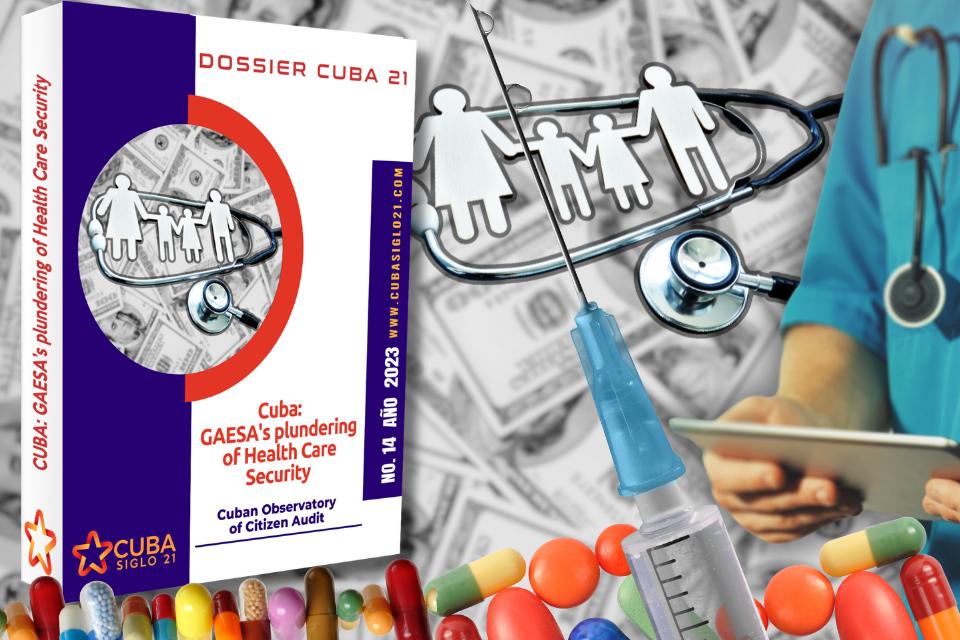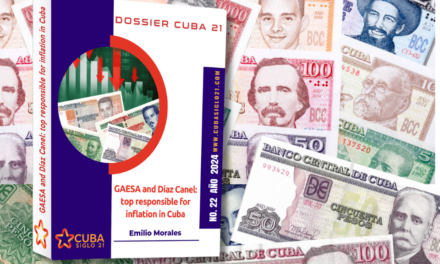Descargar informe completo en español
Download Complete Report in English
The health security of a country is the sum of several factors among which stand out the state and universal accessibility to medical services (infrastructure, equipment, and medical and professional personnel of the health system), universal accessibility to efficient drugs and the coverage and effectiveness of public health services (sewers, sewage treatment, access to drinking water, elimination of vectors that spread diseases, garbage, and waste collection, among others). In all these areas, health security in Cuba is in free fall.
This report, in addition to addressing aspects of health security, such as drug shortages, exposes the methods used by GAESA to appropriate the salaries of Cuban doctors in the so-called “internationalist missions”. The amount of this theft affects not only the doctors but the whole nation.
The Cuban oligarchy through its holding company GAESA not only arbitrarily appropriated those immense resources -no less than 69.8 billion dollars ($69,866,399,679) in a little more than a decade-, belonging to the salaries of the doctors working in the international brigades, but by not reinvesting them in the public health system as the Cuban government had announced will be the case, it also robbed the nation of its right to enjoy comprehensive quality health security. That is what this research shows.
The medicine crisis
The magnitude of the problem is evidenced through an analysis of the monthly reports of missing medicines issued by BioCubaFarma, the entity in charge of providing 60.5% of the Basic Table of Medicines in Cuba (CBMC), which in 2023 is comprised of 633 drugs, 383 of them produced by the aforementioned company, 244 imported by the Ministry of Public Health and 6 manufactured by the Food Industry.
According to the material, available so far from January to August, in the first month of the year, for example, 161 products were missing – 42% of its expected contribution and 25.4% of the total of drugs – of which 24 are issued by control card (the popularly known as tarjetón) and 80 are classified as Priority I, including those related to onco-hematology, mother and child programs, care for seriously ill patients, treatment for HIV patients, and others for outpatient use (Figure 1).
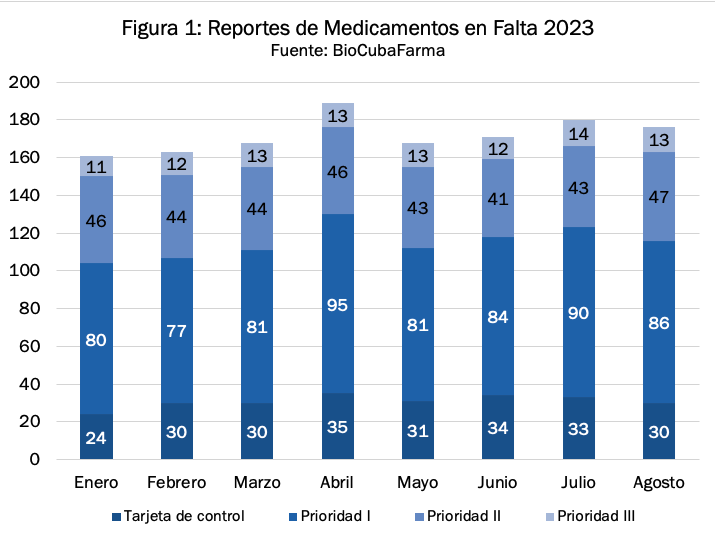
As the table above shows, the trend has remained more or less stable throughout the year, with a peak of 189 shortages in April. It is noteworthy that the products that are most absent are those included in the most important categories, i.e., those dispensed through control cards and those in the Priority I group. Recurrent causes of this situation were “Non-availability of raw materials, finished product and materials” and “Breakage of technological equipment”.
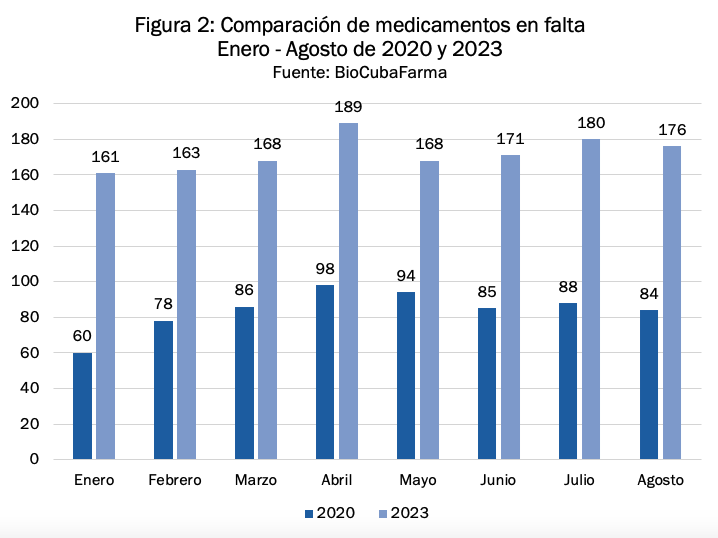
If the 2020 values are compared with the same time range available in 2023 -January-August-, the result shows that, on average, shortages have doubled (Figure 2).
According to the Health Statistical Yearbook, published by MINSAP, in 2022 the first and third causes of death in Cuba were heart and cerebrovascular diseases. Some of the medicines used to combat related ailments have been lacking throughout 2023.
This is the case of captopril 25 mg -used to treat arterial hypertension, congestive heart failure, post-acute myocardial infarction, and diabetic nephropathy-, has been absent from most of the provinces, so that the price of thirty tablets reaches 500.00 CUP in the black market, while in the pharmacy network, twenty tablets have a cost of only 3.00 CUP.
In the treatment of ailments associated with nervous disorders, the absence of medicines has led to cases of violence and suicides, now considered the tenth leading cause of death in the country.
Amitriptyline 25 mg (ten tablets X 0.40 CUP) is used in patients with mental depression, manic-depressive illness, depressive psychosis, major depressive syndrome, appetite disturbances associated with depression, severe neurogenic pain and in the treatment of anorexia or bulimia, among other conditions. Doctors recommend a maintenance dose of 50 to 100 mg daily for three months. On the black market, ten tablets can cost 400.00 CUP.
The average retirement in the country does not exceed 1,528 CUP per month. · The minimum wage was set at 2,100 CUP per month. For a worker with an average salary of 3,800.00 CUP -14 euros/dollars or 16 MLC-, maintaining a treatment of 75 mg daily, three pills, for three months, would cost around 10,800.00 CUP, that is, 3,600.00 each month.
During the month of September 2023, members of the Cuban Observatory of Citizen Audit conducted a field study with visits to pharmacies in 15 provinces and the special municipality Isla de la Juventud. Information was gathered on the lack of medicines that are issued by control card (tarjetón) because they are medicines for chronic conditions and those of first priority.
In all provinces there was a lack of medicines such as analgesics, antibiotics, antihypertensives, antiparasitics, anti-inflammatories, anxiolytics, and antidepressants. In the pharmacies visited in Guantánamo and Camagüey, there were no pediatric medicines. The pharmacies visited in Ciego de Avila were the best supplied in the whole country, although they had a shortage of 30% of basic medicines.
Shortages extend to hospital and laboratory supplies
The shortage not only affects the medicines, but also hospital and laboratory supplies. This has led to the growth of a lucrative informal market in which, for example, an intravenous cannula or a catheter costs 300.00 CUP each. Given the lack of means to work, health professionals have had to ask their patients to look for what they need to be treated, especially for surgical procedures.
A surgeon interviewed for this report stated: “I often have to give a list of what I need to my patient or his family members. In the hospital I often only have the operating room and my own preparation to operate. That is why so many have left.”
According to research published in Cambridge University Press in 2021 by economists Carmelo Mesa Lago and Sergio Diaz Briquets, from 2007 to 2018 hospitals decreased by 32% (all rural ones were closed as of 2011) polyclinics by 9%, while all rural and urban medical smaller posts closed as of 2010.
According to ONEI’s Statistical Yearbook, the country went from having a total of 312,406 employees as optional personnel in 2021, to 281,098 in 2022, 31,308 less. This category includes senior, middle and basic technicians, technologists, and other health graduates.
The reasons for this crisis are internal, not external
It is good to reiterate it. What has happened with the public health system and with the production of medicines in Cuba, reflects a policy of conscious and deliberate neglect of the state’s social responsibilities in that field. This neglect has been prolonged over time and threatens health security due to the contraction of investment, both in this sector and in science and technological innovation. In contrast, spending on “Business services, real estate and rental activities”, linked to the construction of tourist facilities, has been prioritized. Figure 5 shows the imbalance.
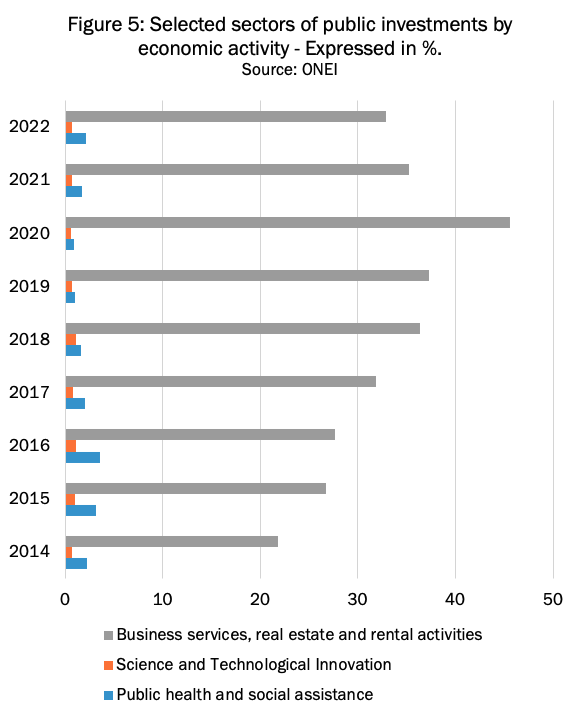
GAESA plundered 69.8 billion dollars from the Public Health System
Contrary to the belief held by the United Nations Special Rapporteur “on the impact of unilateral sanctions on human rights” with data and perspectives fed by Cuban officials such as the director of BioCubaFarma, the decline of the Cuban health system does not respond to external sanctions against the island’s government.
The current living conditions in Cuba are the result of the regime of governance deliberately and consciously sustained by a power elite which, being less than 1% of the population, condemns the vast majority to live in conditions of growing misery. But with specific reference to the causes of the deterioration of health services in Cuba, we must look for them in the plundering of the resources generated by the international medical brigades, under the assumption that they would be invested in the national health system.
According to the Health Statistical Yearbook and the local press, between 2015 and 2018, the island deployed more than 50,000 aid workers (half of them doctors) in 68 countries. At the beginning of 2023, some 23,792 Cuban collaborators in the health sector are providing services in 56 countries.
Most of the export contracts for Cuban medical services involving medical and paramedical personnel are handled by the company Comercializadora de Servicios Médicos, S.A. belonging to the Cuban Ministry of Public Health (MINSAP). There is another entity called ANTEX S.A. under the structure of GAESA and belonging to MINFAR that also manages contracts for medical personnel abroad.
Below, we show the financial scheme that shows the looting of the resources generated by the “brigadista” doctors. See Figure 7.

All the money acquired through the contracts managed by both entities is transferred by them to Banco Financiero Internacional (BFI S.A.), a banking entity owned by GAESA. It should be noted that GAESA is not auditable by the Office of the Comptroller General of the Republic or by any other economic or political institution in Cuba, not even by the Armed Forces to which it is nominally attached.
The value of the total amount of salary confiscations to personnel in the brigades has been estimated at only 70%, although it is notorious that in many cases it has reached 90% depending on the country that hosted them. In this sense, in the period 2008-2022, according to calculations made by Havana Consulting Group, GAESA has pocketed no less than 69.8 billion dollars of the 108.5 billion dollars it has collected from the salaries of the “cooperating” doctors. See Figure 8.
This colossal volume of capital ended up in the hands of GAESA through the International Financial Bank (BFI), but never returned to the reconstruction of hospitals, acquisition of medical equipment and supplies, or to improving the conditions of patient care or the salaries and working conditions of those who work in this sector.
It is noteworthy that in the period analyzed the Cuban government, according to figures published by ONEI, only invested a total of 1.7 billion dollars in the public health sector, which represents 1.61% of what was earned by Cuban medical personnel hired abroad during that time. In contrast, the Cuban regime invested some 24.2 billion dollars in the construction of new hotels in the afore mentioned period. In other words, in the last 13 years, 13 times more was invested in the construction of new hotels than in the health sector.
These figures raise another question. If they spent 24.2 billion in hotel construction, 1.7 billion in health (a total of 25.9 billion in these two expenses) and paid 30.7 billion to the doctors, there is a not inconsiderable “surplus” of 43.8 billion. What was the destination of this “surplus”? Is that where the seed capital of those politically well-connected businesspersons of MSMEs and the luxuries of the oligarchic families have come from? OCAC cannot answer these questions in this report, it only shows the evidence that demonstrates GAESA’s looting through the official figures of the Cuban government.

Hippocratic Oath vs. Due Obedience: sanctions against 6 physicians
The afore mentioned causes create borderline existential situations that challenge the ethics of physicians. If they continue attending patients in these adverse conditions, they are fulfilling their Hippocratic oath, but they are putting the lives they are trying to save at high risk. Their knowledge and personal expertise will not be able to overcome the lack of equipment, supplies, drugs and even the poor sterile conditions of the operating rooms. If they give up medical practice, they will save their conscience and responsibility for any death and perhaps even find another better remunerated activity, but they will leave the population they have sworn to assist helpless. But at the same time, disciplined obedience to the routine of attending to the public in such circumstances may create situations in which they themselves facilitate a tragedy among their patients. That is the crossroads faced today by 6 doctors at the Bayamo hospital who could not save the life of a patient by accepting the challenge of operating on him under such adverse circumstances.
In this case, the patient’s mother works for the Public Prosecutor’s Office and took the doctors to court, not the provincial and national authorities of the health system. However, it is the provincial and national health authorities who should answer in court why they have agreed to comply with the central government’s order to force doctors to provide services without the necessary means to reasonably ensure successful outcomes.
Public health in Cuba is not free, it costs lives. GAESA and all those involved in this looting and its coverup must answer for the collapse of the country’s health security system.
Conclusions
- The health security of the Cuban people is not a victim of external economic sanctions, but of the rapacity of a new oligarchy that between 2009 and 2022 (as officially recorded statistics reflect) has appropriated at least 69.8 billion dollars from the salaries of the doctors in the international brigades that were never invested in the national health system as the Cuban government had promised. They didn’t just steal from the doctors; they stole from the nation. On the one hand, they took the salaries of Cuban doctors; on the other hand, they stole from the public health system whose destruction was facilitated by the GAESA oligarchy appropriation of those resources. The victims here were not only the doctors, but all citizens. The victimizers were not only public health officials, but the members of the new oligarchy linked to GAESA.
- Health security, a strategic component of Citizen Security, is in sharp decline. According to official figures, the number of hospitals in Cuba decreased by 32% between 2007 and 2018. The country went from having a total of 312,406 employees as medical personnel in 2021 to 281,098 in 2022. Health personnel decreased by 31,308 less in just 12 months (2021-2022). This category includes senior, middle and basic technicians, technologists, and other health graduates. The shortage of basic medicines has doubled this year compared to 2020. From 84 missing medicines in 2020, in 2023 the figure went up to 172.
- The acquisition of missing medicines on the black market, in addition to the dangers associated with counterfeit drugs, are unaffordable for many Cubans. A monthly treatment for chronic diseases that can only be purchased on the black market can be equivalent to more than 200% of the minimum pension. For example, Enapranil for high blood pressure and Amitriptyline for depression can cost 3,600 CUP, which represents 236% of the minimum pension of 1,528 CUP.
- The Cuban state has gradually disengaged from its responsibility to provide universal access to quality health services and a basic set of pharmaceuticals to the population. The oligarchy is now trying out mechanisms of medical care through the new MSMEs, which further distances the state from its responsibility.
- Health security today has two strata: those who have relatives in the diaspora or other means to access to dollars, and those who depend on income in local currency. Without dollars it is not possible to pay on the black market the prices of health supplies for hospital treatment and drugs for domestic use.
- The crisis of citizen health security is another result of the structural transformation of the country’s political economy that has disregarded the previous social commitments of the so-called communist state. That is what the statistics show.
- The harsh reality is that health security is not part of the priorities of the new Cuban oligarchic state. Just as in the area of food security, investments in the public health sector are not dictated by the purpose of covering the needs of society, but by the profit rates that can be obtained in comparison with other sectors. That is why they do not hesitate to export medical personnel to whom 70 to 90% of their salaries are expropriated and deposited in the International Financial Bank under GAESA’s control. The dollars generated by those treated as slaves in white coats abroad are for the new oligarchy, not to protect the health security of the Nation.
- The current health insecurity of the population is the result of deliberate decisions emanating from the Cuban oligarchy that controls GAESA and the Díaz Canel government itself. It cannot be justified based on external political factors such as U.S. sanctions or fortuitous factors such as a pandemic.
Recommendations
RECOMMENDATIONS TO THE CUBAN STATE
- GAESA (including the International Financial Bank under its control), the Ministry of Public Health and the companies in charge of the export of medical services must open their books to fiscal and public scrutiny and proceed immediately to reimburse to the national health security system the 69.8 billion that they have expropriated from the salaries of the doctors in the international brigades.
- The Cuban State -its Public Prosecutor’s Office and Comptroller General’s Office- must demand that this form of extortion and theft of salaries from medical personnel or any other abroad cease immediately and establish the mechanisms for the reimbursement, in this case, of the resources stolen to date from the national health system.
RECOMMENDATION TO CUBAN CIVIL SOCIETY ORGANIZATIONS
- To continue the investigations being carried out by different civil society organizations on the theft of salary resources from a sector of the country’s workers and the national health system; as well as to keep the population, foreign governments, the relevant international mechanisms of the United Nations Convention Against Corruption and international public opinion in general informed on their findings.
Descargar informe completo en español
Download Complete Report in English

